The Mechanical and Microstructural Properties of Composite Structures Made of a Cement-Tailing Backfill and Rock Core
Abstract
:1. Introduction
2. Materials and Methods
2.1. Materials of Cement-Tailing Backfill
2.1.1. Tailings
2.1.2. Binder and Water
2.2. Materials of Inner Rock Core
2.3. Preparation of the CTB-RC Specimens
- The rock cores were processed into small RC specimens with a diameter of 25 mm and a height of 100 mm (Figure 6a).
- The poly vinyl chloride (PVC) pipes were cut into sections with an inner diameter of 50 mm and a height of 100 mm and were cut along the side wall for subsequent demolding (Figure 6b).
- The stirred slurry was injected into the PVC mold with an RC specimen inside, as shown in Figure 6c.
- The molds were kept stationary for six hours until the slurry sank and shrunk, and the liquid level dropped. Then, the slurry was injected again until the liquid level was consistent with the IRC height. This process was repeated until the height of the whole sample was similar to the height of the IRC.
- We then cured the CTB-RC specimens for 28 days using a standard curing box (Curing temperature: 20 ± 5 °C, relative humidity: 95 ± 5%).
2.4. Experimental Installations and Tests
2.4.1. Uniaxial Compressive Strength Test
- The CTB-RC specimen was placed at the center of the bearing plate of the press machine, and the spherical seat was adjusted to place the two ends of the specimen in uneven contact. In addition, a flatness check was performed to make sure the plate was level before loading.
- According to some previous studies and experimental practice and experience [37], the load was applied at a constant speed at 100 N∙s−1 until the CTB-RC specimen was damaged. The loading speed was slowed down to 0 N∙s−1 after the specimen was completely damaged.
- The crack propagation process and failure mode and related data during the loading process were observed, photographed, and recorded.
2.4.2. Triaxial Compressive Strength Test
- The CTB-RC specimen was fixed in the extensometer and connected with the testing machine. To prevent the penetration of external lubricating oil and its negative effects on the test results, the CTB-RC specimen was wrapped with a rubber sleeve.
- The confining pressure was set as 300 KPa.
- A loading speed of 1 mm∙min−1 was used at first until the axial load reached 2 KN, which is about 60–70% of the peak axial stress of the specimen.
- Then, a loading speed of 0.02 mm∙min−1 was used, and a deformation control loading was applied to prevent a rock burst. This can also help us observe the change of the stress–strain curve after reaching peak deviator stress.
- We stopped loading until the CTB-RC specimen could remain substantially unchanged as the strain increased, which means it had already entered the residual strength phase.
- We recorded and observed the damage process and date during loading.
2.4.3. Scanning Electron Microscopy Analysis
3. Results and Discussion
3.1. Effect of CTR and SC on the UCS Performance of the CTB-RC Specimens
3.1.1. Analysis on the Failure Characteristics
- At the beginning of loading, the ECTB of the CTB-RC specimens was the first to show a crack, as shown in Figure 9.
- As the experiment progressed, more cracks appeared in the ECTB, and the cracks expanded further. Then, the IRCs were destroyed. As shown in Figure 10, the failure modes of both the ECTB and the IRC involved basically the same shear failure.
- This indicates that the high CTR of the ECTB exerted some beneficial effects on the failure results. With a CTR of 1:4, the CTB-RC specimen could maintain its integrity, and the ECTB could be completely peeled off from the IRC after being damaged (Figure 10a–c). With a CTR of 1:6, the ECTB could not completely peel off because of its serious damage (Figure 10d). With a CTR of 1:8, the specimen was broken into pieces and could not be kept intact.
3.1.2. Analysis of the UCS Values
- The UCS values of CTB-RC specimens is 13–17 times stronger than that of the CTB specimens, which means that the compressive strength of the CTB-RC specimen is considerably greater than that of the same-sized CTB specimen.
- The UCS values of CTB-RC specimens is only 32–38% that of RC specimen A, which is considerably lower than the original rock strength of the same size.
- The UCS values of the CTB-RC specimens is 13–26% higher than that of RC specimen B. Thus, the backfill could effectively protect the IRC, even if no constraint and no lateral pressure were present.
- The UCS values of the CTB-RC specimens increases with the CTR and the SC of the slurry. This means that the protection degree of the IRC from the ECTB increased with the CTR and the SC of the slurry.
- The relationship between the UCS values of the CTB-RC specimens and the CTR and the relationship between the UCS and SC were analyzed by a regression analysis. According to the correlation coefficient R2, a linear relation fits best. The relationship curves and equations are shown in Figure 11.
3.2. The Stress–Strain and Failure Characteristic of the CTB-RC Specimen under a Triaxial Compression Strength Test
3.2.1. Analysis of the Stress–Strain Curves
- Micro-crack closure stage (AB): The curves of both the rock and CTB-RC specimens have a concave shape, which indicates that the internal crack gradually closed under compressive pressure, and the specimen generated nonlinear deformation. The ECTB of the CTB-RC specimen was under pressure with the IRC together, but the IRC was the main carrier. However, in the experiments, this part of the curve is very short and difficult to observe.
- Elastic deformation stage (BC): Both the rock specimen and the CTB-RC specimen entered an elastic deformation stage. The curve is approximately straight, which is proportional and conforms to Hooke’s law. Stress concentration occurred around the inner primordial pores but did not reach a magnitude that caused the internal microcracks to expand and rupture. The slope of the line is regarded as the elastic modulus of the CTB specimens.
- Inelastic deformation stage (CD): The curves of both the rock and CTB-RC specimens became convex, thereby suggesting that they started to undergo inelastic deformation. Microcracks began to spread steadily individually, and the volume deformation began to accelerate during this stage. the stress on the inner microscopic defect reached and exceeded the limit value and reached the first stress peak at point D. The long-term strength of the rock specimen (the strength corresponding to the point at which the rock retains the same volume) was approximately 80% of the peak deviator stress, while the long-term strength of the CTB-RC specimen was more than 90% of the peak deviator stress.
- Formation of the fault Stage (DE): The rock specimen gradually formed severe fracture damage and a rupture fault. The IRC of the CTB-RC specimen formed a fault plane, too, and its internal RC structure was destroyed after the first peak of the deviator stress. However, under the combined support of the ECTB and the IRC, the stress field value of the internal micro-defect still did not reach the limit stress value of the ECTB. The microcracks began to expand, bifurcate, detour and communicate, and rupture; the original damage occurred, and the CTB-RC specimen entered a weakening stage after the first stress peak.
- Residual deformation stage (EF) for the rock specimen: The rock specimen broke down at point E and then entered the residual deformation stage.
- Compressive strength rebound stage (EF) for the CTB-RC specimen: Due to the constraint of the ECTB, the compressive strength rebounded. The curve appears abrupt, showing the second peak deviator stress at point F. The ECTB then continued to be inelastically deformed, and the original microdamage inside began to intensify.
- Compressive strength weakening stage (FG): The cracks in the IRC developed rapidly, and the compressive strength was rapidly weakened. The ECTB and the IRC worked together. Then, the IRC experienced secondary damage at point G.
- ECTB completely destroyed stage (GH): With the complete failure of the IRC, the ECTB became the main carrier, and its internal microdefects were squeezed continuously. Moreover, the damage gradually increased until the ECTB was completely destroyed. The curve reached the third peak deviator stress at point H.
- Residual deformation stage after point H: Both the ECTB and the IRC were destroyed. The cracks in the ECTB show expansion, communication, bifurcation, and detour. The compressive strength decreased rapidly with an increase in axial strain. Then, it entered the stage of residual deformation.
3.2.2. Analysis of the Failure Characteristics
3.3. Microstructure Characteristics of the Fracture Surface
4. Conclusions
Author Contributions
Funding
Conflicts of Interest
References
- He, M.C.; Xie, H.P.; Peng, S.P.; Jiang, Y.D. Study on rock mechanics in deep mining engineering. Chin. J. Rock Mech. Eng. 2005, 16, 2803–2813. [Google Scholar]
- Wang, Q.; Ren, F.Y. Mining Science, 2nd ed.; Metallurgical Industry Press: Beijing, China, 2011; pp. 327–332. ISBN 978-7-5024-5490-6. [Google Scholar]
- Liu, C.; Han, B.; Sun, W.; Wu, J.X.; Yao, S.; Hu, H.Y. Experimental study of strength of backfillings of cemented rock debris and its application under low temperature condition. Chin. J. Rock Mech. Eng. 2015, 34, 139–147. [Google Scholar]
- Han, B.; Wang, X.L.; Xiao, W.G. Estimation and evaluation of backfill strength in underground stope based on multivariate nonlinear regression analysis. J. Min. Saf. Eng. 2012, 5, 714–718. [Google Scholar]
- Song, Z.Q.; Cui, Z.D.; Xia, H.C.; Tang, J.Q.; Wen, Z.J. The fundamental theoretical and engineering research on the green safe on coal pillar mining model by mainly using coal gangue backfill. Chin. J. Coal Soc. 2010, 5, 705–710. [Google Scholar]
- He, G.C.; Liu, Y.; Ding, D.X.; Zhang, Z.J. Strength characteristic of cemented waste rock backfills and its application. J. Min. Saf. Eng. 2013, 30, 74–79. [Google Scholar]
- Xue, G.L.; Yilamz, E.; Song, W.D.; Cao, S. Mechanical, flexural and microstructural properties of cement-tailings matrix composites: Effects of fiber type and dosage. Compos. Part B 2019, 172, 131–142. [Google Scholar] [CrossRef]
- Xue, G.L.; Yilmaz, E.; Song, W.D.; Cao, S. Compressive strength characteristics of cemented tailings backfill with alkali-activated slag. Appl. Sci. 2018, 8, 1537. [Google Scholar] [CrossRef] [Green Version]
- Junior, A.N.; Ferreira, S.R.; Filho, R.D.T.; Fairbairn, E.M.R. Effect of early age curing carbonation on the mechanical properties and durability of high initial strength Portland cement and lime-pozolan composites reinforced with long sisal fibres. Compos. B Eng. 2019, 163, 351–362. [Google Scholar] [CrossRef]
- Chen, X.; Shi, X.Z.; Zhou, J.; Chen, Q.S.; Li, E.; Dy, X.G. Compressive behavior and microstructural properties of tailings polypropylene fibre-reinforced cemented paste backfill. Constr. Build. Mater. 2018, 190, 211–221. [Google Scholar] [CrossRef]
- Yang, L.; Yilmaz, E.; Li, J.; Liu, H.; Jiang, H. Effect of superplasticizer type and dosage on fluidity and strength behavior of cemented tailings backfill with different solid contents. Constr. Build. Mater. 2018, 187, 290–298. [Google Scholar] [CrossRef]
- Mirzababaei, M.; Arulrajah, A.; Horpibulsuk, S.; Soltani, A.; Khayat, N. Stabilization of soft clay using short fibers and polyvinyl alcoholy. Geotext. Geomembr. 2018, 46, 646–655. [Google Scholar] [CrossRef]
- Mirzababaei, M.; Arulrajah, A.; Horpibulsuk, S.; Aldava, M. The shear stress ratio of the fibre-reinforced clay soils at large shear displacement was found to be relatively independent of the stress history of the soil. Geotext. Geomembr. 2017, 45, 422–429. [Google Scholar] [CrossRef]
- Mirzababaei, M.; Arulrajah, A.; Haque, A.; Nimbalkar, S.; Mohajerani, A. Effect of fiber reinforcement on shear strength and void ratio of soft clay. Geosynth. Int. 2018, 25, 471–480. [Google Scholar] [CrossRef]
- Tan, Y.Y.; Wang, J.; Song, W.D.; Xu, L.H.; Cao, S. Experimental study on mechanical properties of cemented tailings backfill under cycle dynamic loading test. J. Min. Saf. Eng. 2019, 1, 184–197. [Google Scholar]
- Zhu, P.R.; Song, W.D.; Cao, S.; Wan, F.; Zheng, D. Tensile mechanical response mechanism of cemented backfills under blasting load. J. Min. Saf. Eng. 2018, 35, 605–611. [Google Scholar]
- Tan, Y.Y.; YU, X.; Davide, E.; Xu, L.H.; Song, W.D. Experimental study on dynamic mechanical property of cemented tailings backfill under SHPB impact loading. Int. J. Min. Metall. Mater. 2019, 4, 404–416. [Google Scholar] [CrossRef]
- Razak, K.; Ganda, M.S.; Budi, S. Stability analysis of paste fill as stope wall using analytical method and numerical modeling in the kencana underground gold mining with long hole stope method. Procedia Earth Planet. Sci. 2013, 6, 474–484. [Google Scholar]
- Xu, W.B.; Song, W.D.; Wang, D.X.; Yang, B.G.; Pan, W.D. Energy dissipation properties of cement backfill body under triaxial compression conditions. J. China Univ. Min. Technol. 2014, 5, 808–814. [Google Scholar]
- Kimle, R.; William, F.; Bawden, G. Field properties of cemented paste backfill at the Golden Giant Mine. Min. Technol. Trans. Inst. Min. Metall. A 2005, 7, 65–80. [Google Scholar]
- Yu, X.F. Rock Mechanics and Mining Calculation in Information Age; Science Press: Beijing, China, 1991; pp. 121–159. ISBN 7030021401. [Google Scholar]
- Yu, S.B.; Yang, X.C.; Dong, K.C.; Jie, L.K.; Sun, X.M. Space-time rule of the control action of filling body for the movement of surrounding rock in method of the delayed filling open stoping. J. Min. Saf. Eng. 2015, 3, 74–79. [Google Scholar]
- Tesarik, D.R.; Seymour, J.B.; Yanske, T.R. Longterm stability of a backfilled room-and-pillar test section at the buick mine missouri. Int. J. Rock Mech. Min. Sci. 2009, 46, 1182–1196. [Google Scholar] [CrossRef]
- Li, P.; Ren, F.H.; Cai, M.F.; Guo, Q.F.; Wang, H.F.; Liu, K. Investigating the mechanical and acoustic emission characteristics of brittle failure around a circular opening under uniaxial loading. Int. J. Min. Met. Mater. 2019, 10, 1217–1234. [Google Scholar] [CrossRef]
- You, X.; Ren, F.Y.; He, R.X.; Ding, H.X. Research on compressive strength of cemented filling body in subsequent filling at the stage of open stope. J. Min. Saf. Eng. 2017, 34, 163–169. [Google Scholar]
- Wang, Z.G.; Wang, M.; Zhang, G.Q.; Li, Y.L. Research of infrared radiation characteristics of the combined model of filling body and surrounding rock during shear rupturing. Conserv. Util. Min. Resour. 2016, 5, 64–69. [Google Scholar]
- Wang, Z.G.; Li, Z.Y.; Gu, N.M. Study on the acoustic emission fracture characteristics of the backfilling and surrounding rock combined model under cyclic loading and unloading. Met. Mine 2018, 8, 51–57. [Google Scholar]
- Wang, Z.G.; Li, Z.Y.; Li, Y.L. Study on fracture mechanism of loading and unloading of filling and surrounding rock based on field strain. J. Yangtze River Sci. Res. Inst. 2017, 34, 1–6. [Google Scholar]
- Cai, S.J. Foundation of Mine Filling Mechanics, 2nd ed.; Metallurgical Industry Press: Beijing, China, 2009; ISBN 9787502449902. [Google Scholar]
- Wu, D.; Cai, S.J. Coupled effect of cement hydration and temperature on hydraulic behavior of cemented tailings backfill. J. Cent. South. Univ. 2015, 22, 1956–1964. [Google Scholar] [CrossRef]
- Sun, G.H.; Ye, H.T.; Liu, Z.Y. Study on the mechanism and acoustic emission characteristics of the filling body and rock pillar system. Min. Res. Dev. 2018, 3, 49–52. [Google Scholar]
- Wang, M.X.; Xu, M.G.; Hu, X.L.; Liu, Y.T. Acoustic emission monitoring test for the effect of top filling on filling body-surrounding rock. Nonferr. Met. Eng. 2018, 5, 72–76. [Google Scholar]
- Fang, K.; Fall, M. Effects of curing temperature on shear behavior of cemented paste backfill-rock interface. Int. J. Rock Mech. Min. Sci. 2018, 112, 184–192. [Google Scholar] [CrossRef]
- Song, W.D.; Zhu, P.R.; Qi, W.; Tang, Y.N. Coupling mechanism of rock-backfill system under triaxial compression. J. Min. Saf. Eng. 2017, 3, 573–579. [Google Scholar]
- Tan, Y.Y.; YU, X.; Song, W.D.; Wang, H.P.; Cao, S. Experimental study on combined pressure-bearing. mechanism of filling body and surrounding rock. J. Min. Saf. Eng. 2018, 8, 1071–1076. [Google Scholar]
- Liu, Z.X.; Li, X.B.; Zhao, G.Y.; Li, Q.Y.; Wang, W.H. Three-dimensional energy dissipation laws and reasonable matches between backfill and rock mass. Int. J. Rock Mech. Min. Sci. 2010, 2, 344–348. [Google Scholar]
- Liu, Z.X.; Li, X.B.; Dai, T.G.; Cao, P. On damage model of cemented tailings backfill and its match with rock mass. Rock Soil Mech. 2006, 9, 442–446. [Google Scholar]
- Zhou, X.M.; Wang, Y.; Tang, S.H. Constitutive relation of stress field between surrounding rock and filling body in jin chuan no.2 mining area. Q. CIMR 1991, 4, 1–6. [Google Scholar]
- Qiu, J.P.; Yang, L.; Xing, J.; Sun, X.G. Analytical solution for determining the required strength of mine backfill based on its damage constitutive model. Soil Mech. Found. Eng. 2018, 6, 371–376. [Google Scholar] [CrossRef]
- Liu, Z.X.; Lan, M.; Xiao, S.Y.; Guo, H.Q. Damage failure of cemented backfill and its reasonable match with rock mass. Trans. Nonferr. Met. Soc. 2005, 3, 954–959. [Google Scholar] [CrossRef]
- Zhao, H.J.; Ma, F.S.; Li, G.Q.; Ding, D.M.; Gao, J.K. Analysis and mechanism of ground movement, deformation and fracture induced by underground backfill mining. Chin. J. Geotech. Eng. 2008, 5, 23–28. [Google Scholar]
- Regassa, B.; Xu, N.X.; Mei, G. An equivalent discontinuous modeling method of jointed rock masses for DEM simulation of mining-induced rock movements. Int. J. Rock Mech. Min. Sci. 2018, 180, 1–14. [Google Scholar] [CrossRef]
- Peng, S.S.; Cheng, J.Y.; Du, F.; Xue, Y.T. Underground ground control monitoring and interpretation, and numerical modeling and shield capacity design. Int. J. Min. Sci. Technol. 2018, 10, 233–248. [Google Scholar] [CrossRef]
- Wang, X.M.; Gu, D.S.; Zhang, Q.L. Theory of Backfilling Activity and Pipeline Transportation Technology of Backfilling Deep Mines; Central South University Press: Changsha, China, 2010; pp. 55–56. ISBN 9787548701521. [Google Scholar]
- Deng, D.Q.; Gao, Y.T.; Wu, S.C.; Yu, W.J. Experimental study of destructive energy dissipation properties of backfill under complicated stress condition. Rock Soil Mech. 2010, 3, 737–742. [Google Scholar]
- Gonzalo, S.; Fourie, A.; James, D. Cyclic Shear Response of Cemented Paste Backfill. Geotech. Geoenviron. Eng. 2017, 143, 4016082. [Google Scholar]
- ASTM Standard D421-85. Standard Practice for Dry Preparation of Soil Samples for Particle Size Analysis and Determination of Soil Constants; Annual Book of ASTM Standards, 04.08; American Society of Testing Material International: West Conshohocken, PA, USA, 2007; pp. 8–9. Available online: www.astm.org (accessed on 11 February 2020).
- Benzaazoua, M.; Bussière, B.; Demers, I.; Aubertin, M.; Fried, E.; Blier, A. Integrated mine tailings management by combining environmental desulphurization and cemented paste backfill, Application to mine Doyon. Min. Eng. 2009, 24, 330–340. [Google Scholar] [CrossRef]
- Li, Y.F.; Zhang, J.M.; Deng, F.; Bai, S.W. Experimental study on strength characteristics of tailings cement backfilling at deep-seated mined-out area. Rock Soil Mech. 2005, 6, 865–868. [Google Scholar]
- Tan, Y.Y.; Cao, S.; Song, W.D.; Fu, J.X. Hydrophilic characteristics experiment and action mechanism of ore mass in Chengchao iron mine. J. Northeast. Univ. 2015, 5, 163–168. [Google Scholar]
- Fairhurst, C.E.; Hudson, J.A. Draft ISRM suggested method for the complete stress-strain curve for intact rock in uniaxial compression. Int. J. Rock Mech. Min. Sci. 1999, 36, 279–292. [Google Scholar]
- Zhang, L.; Wang, B.X.; Yang, T. Research of rock triaxial compression test with multilevel confining pressure. Site Investig. Sci. Technol. 2007, 3, 6–8. [Google Scholar]
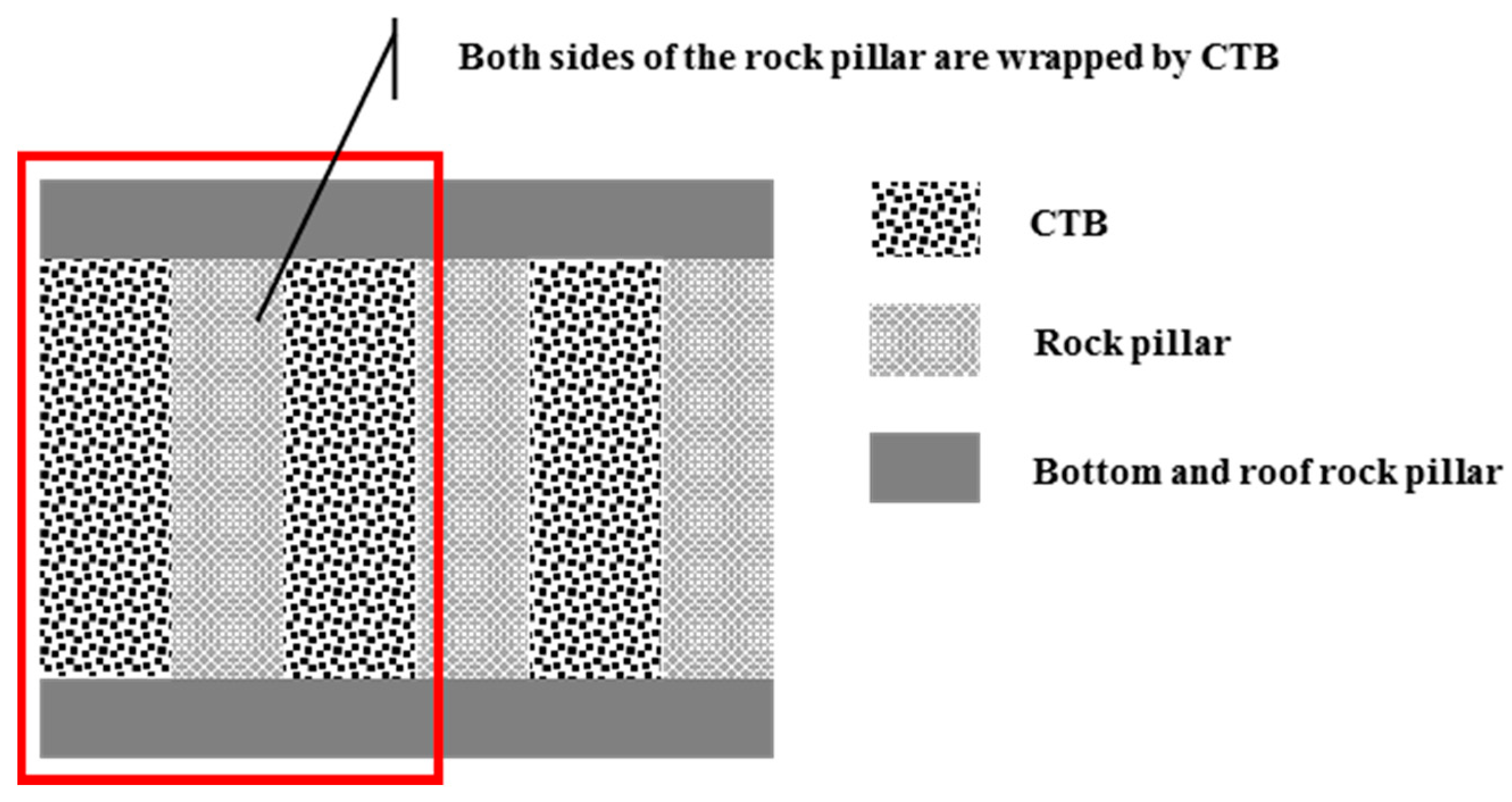
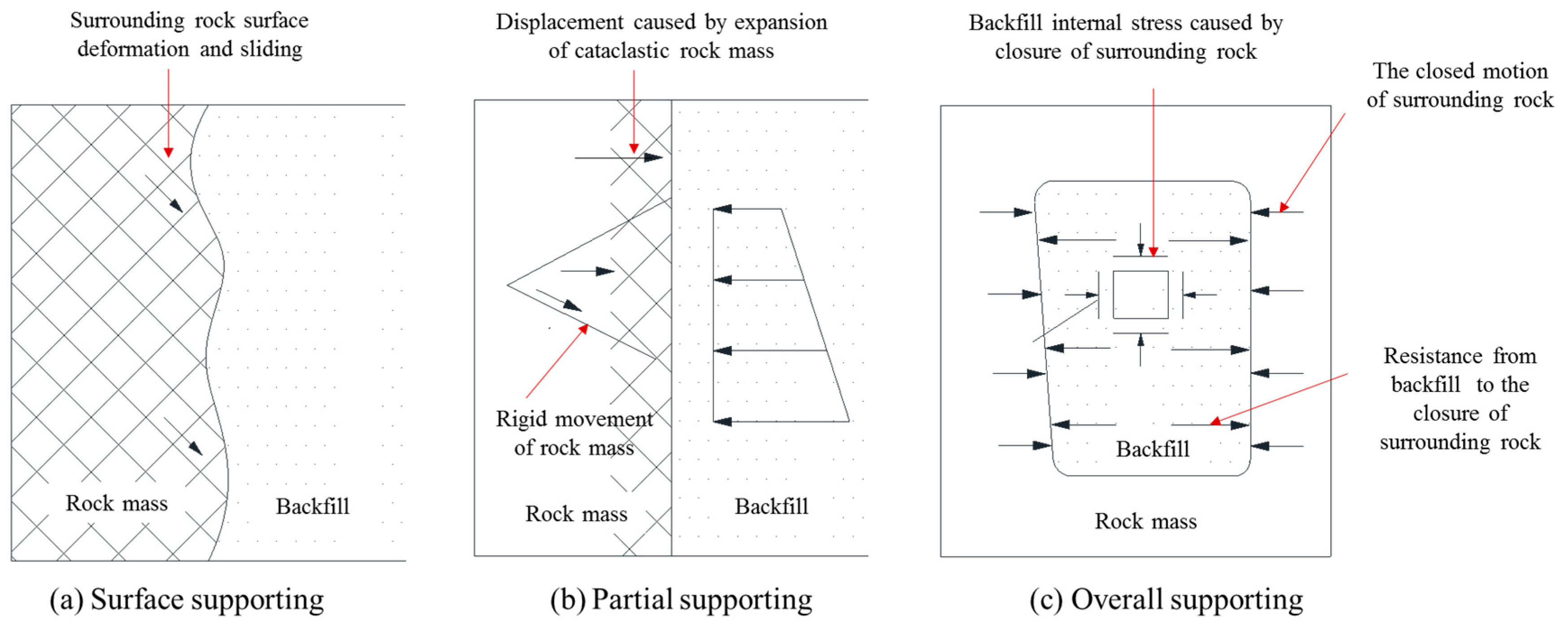
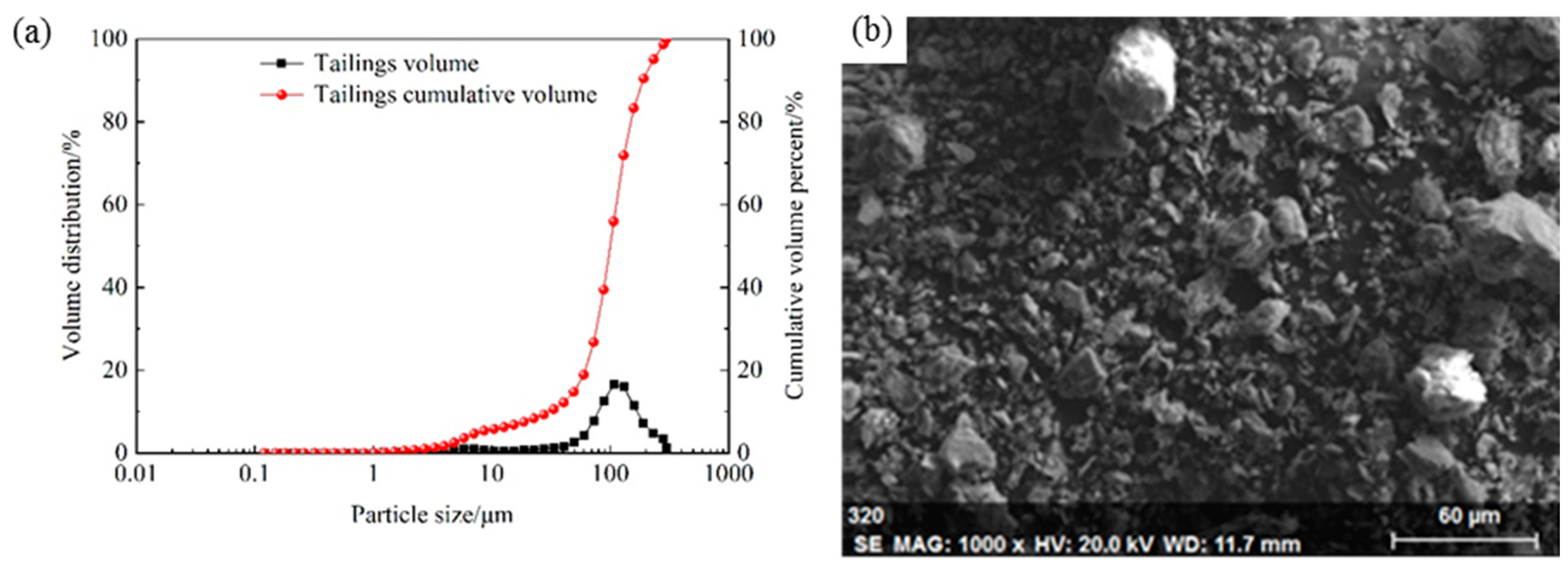


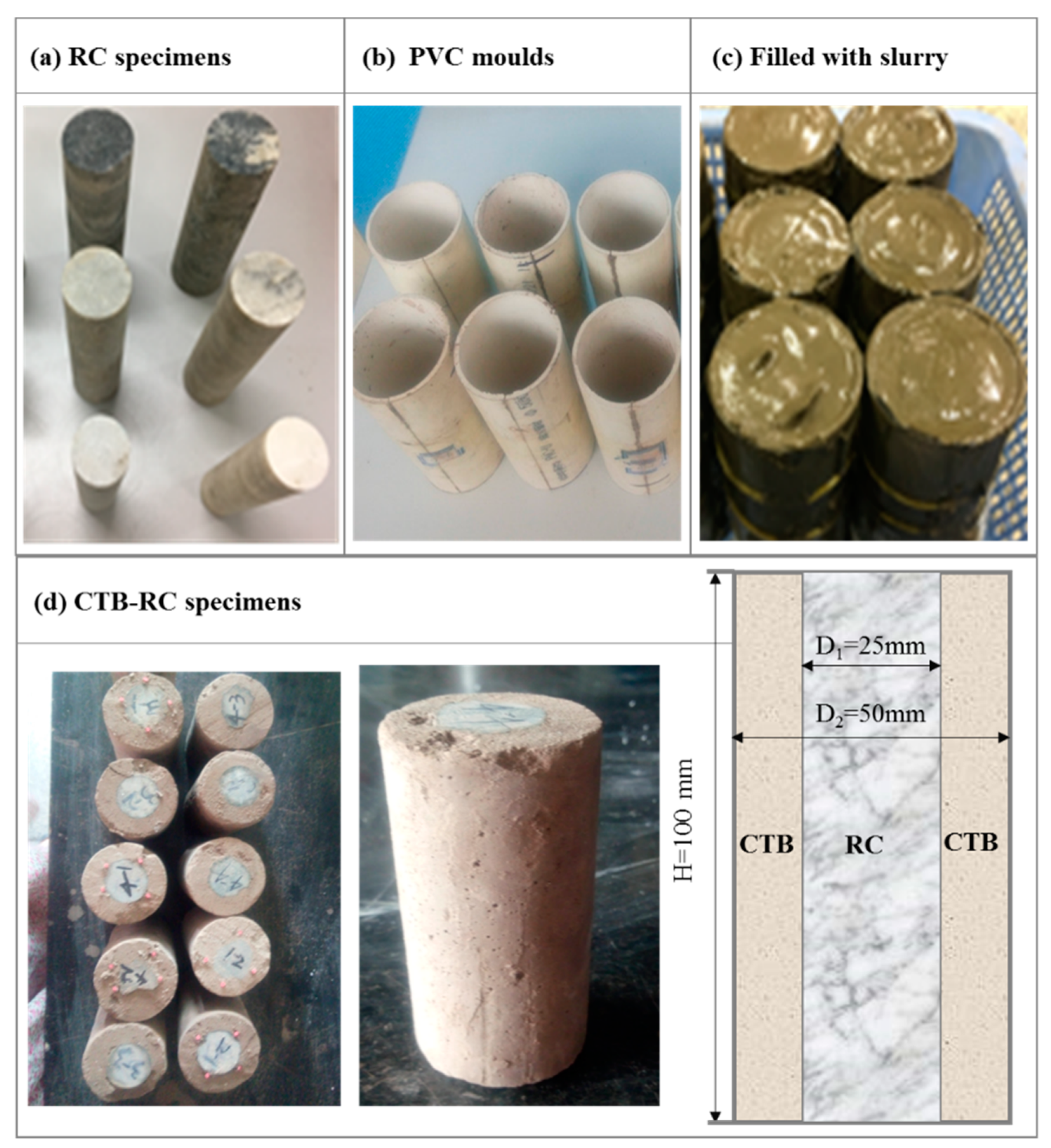
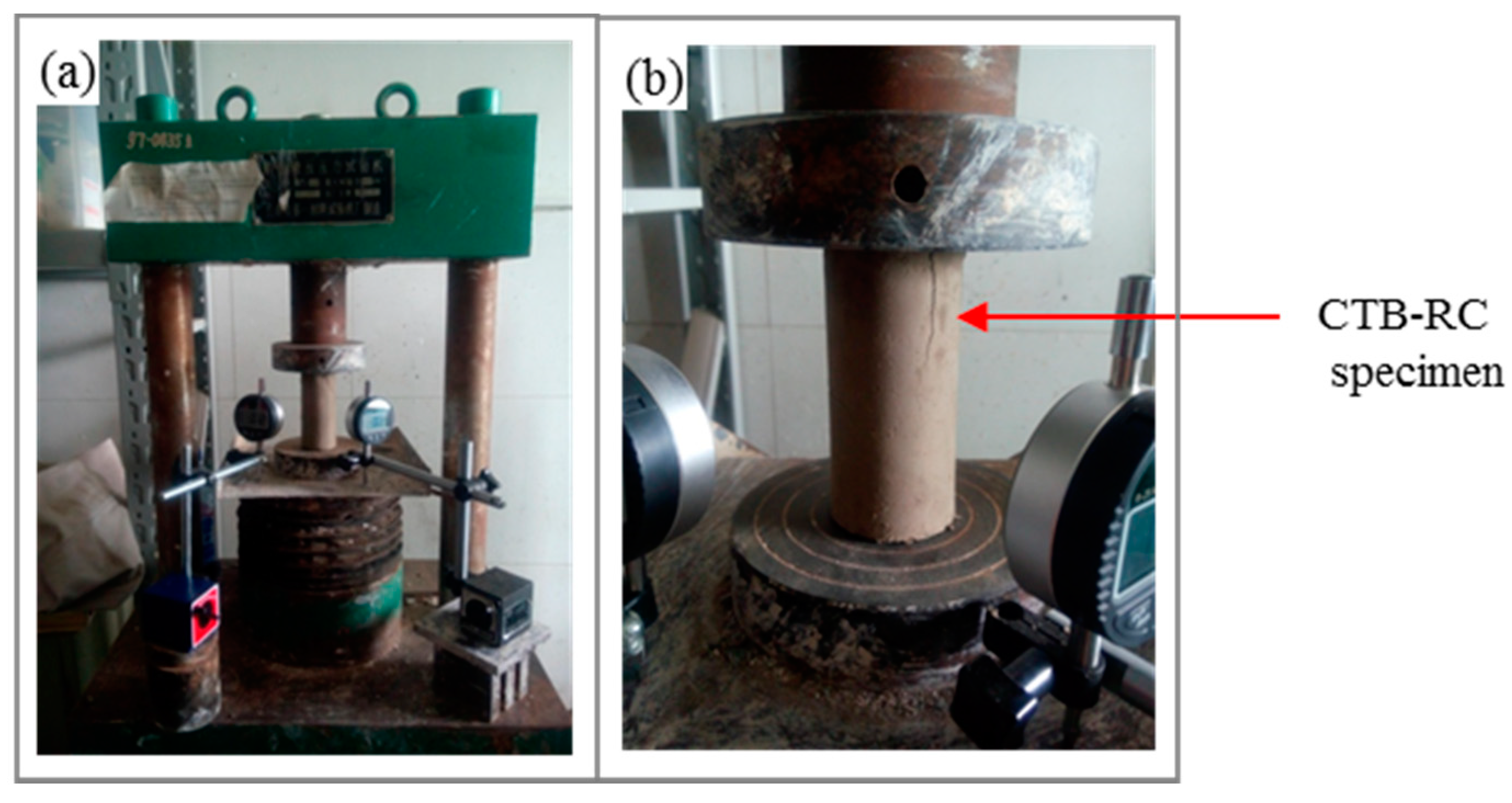
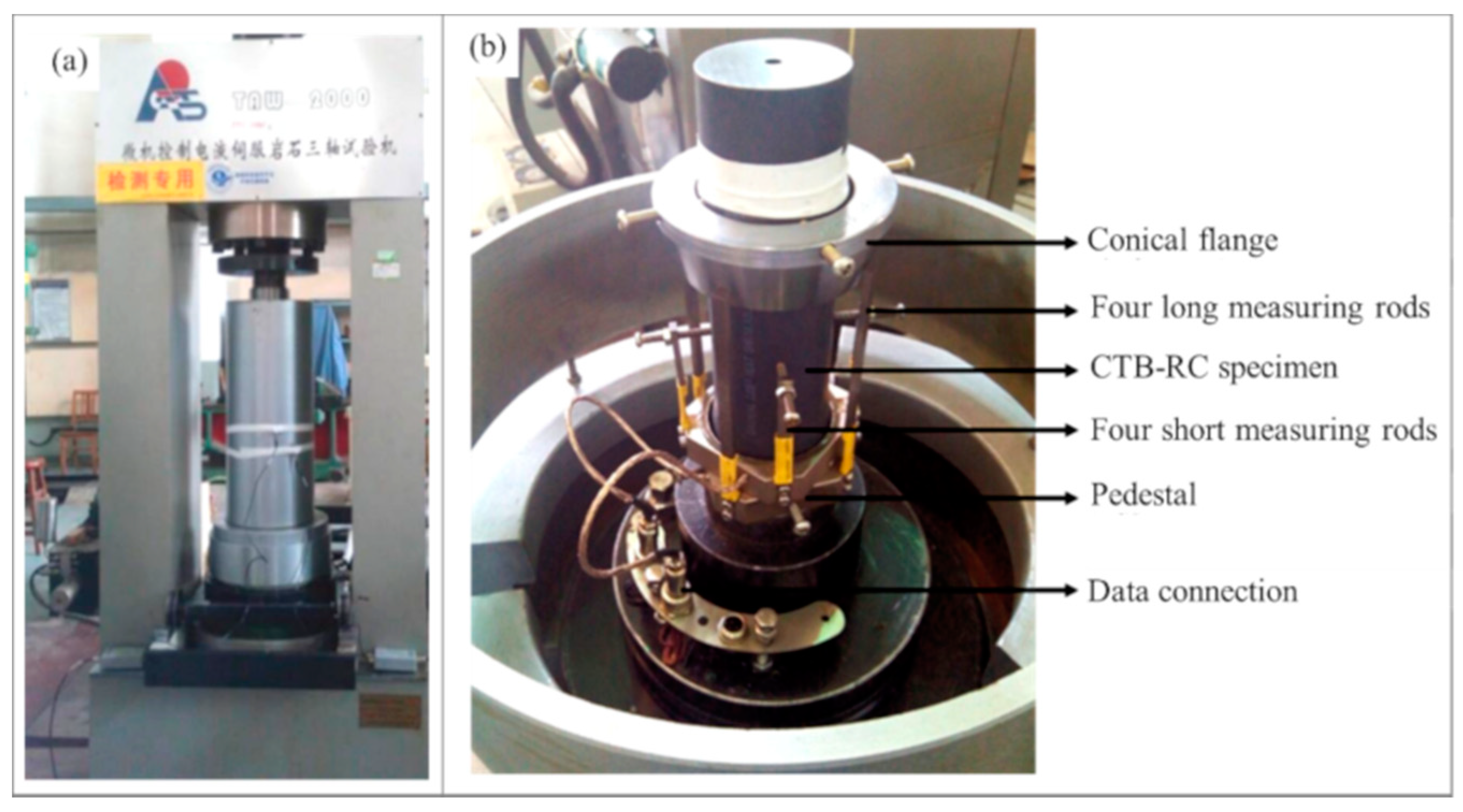
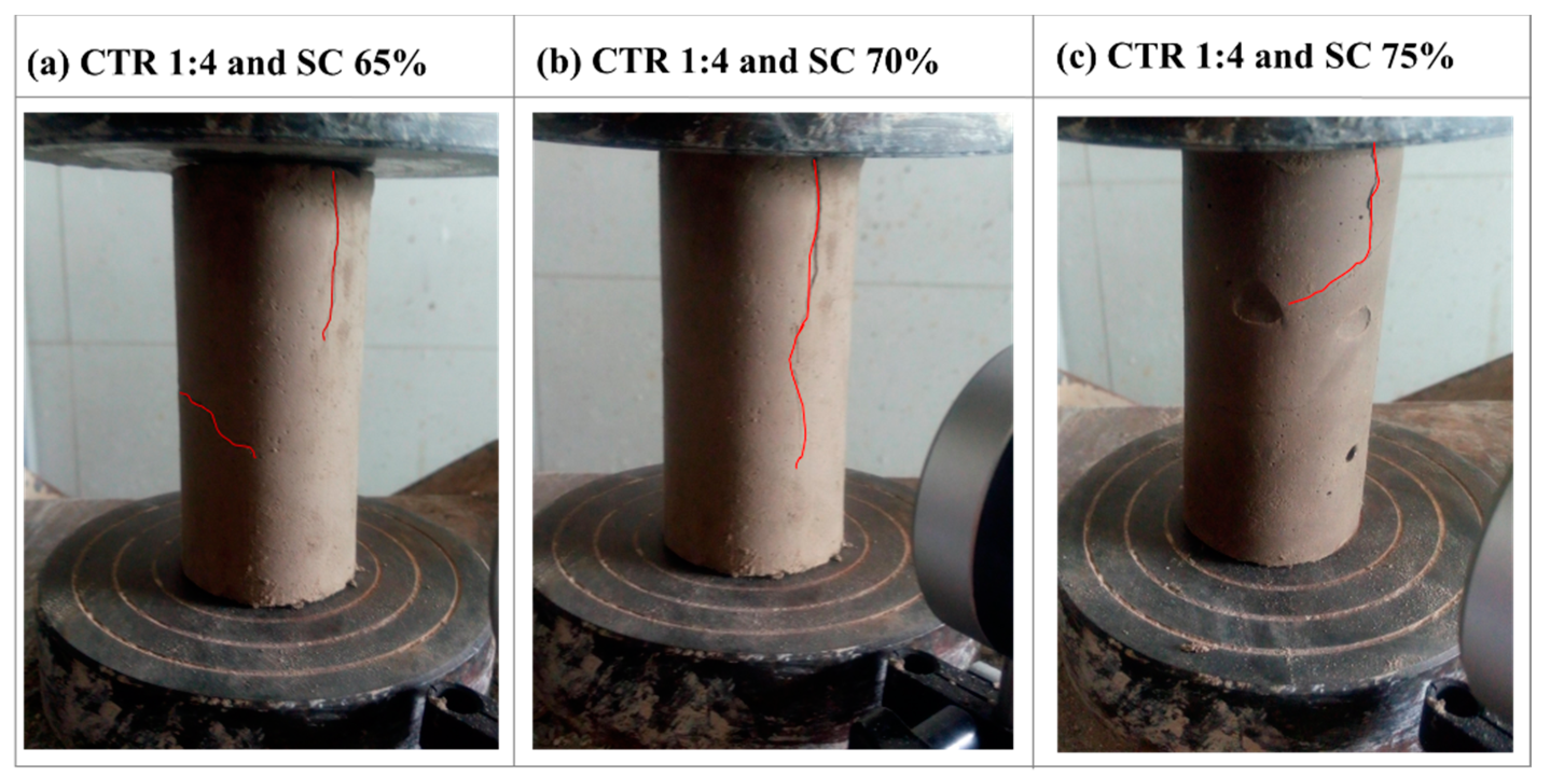
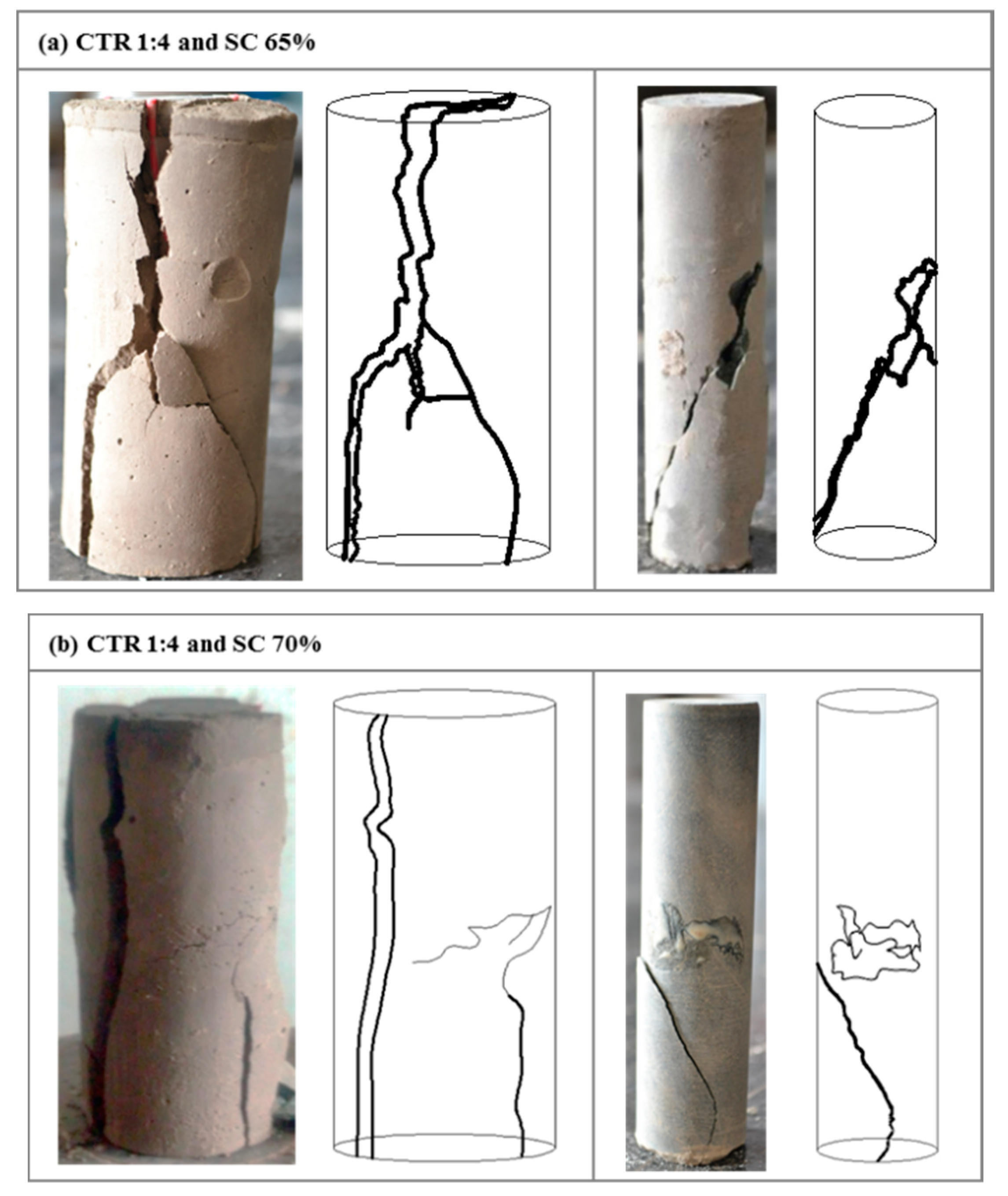
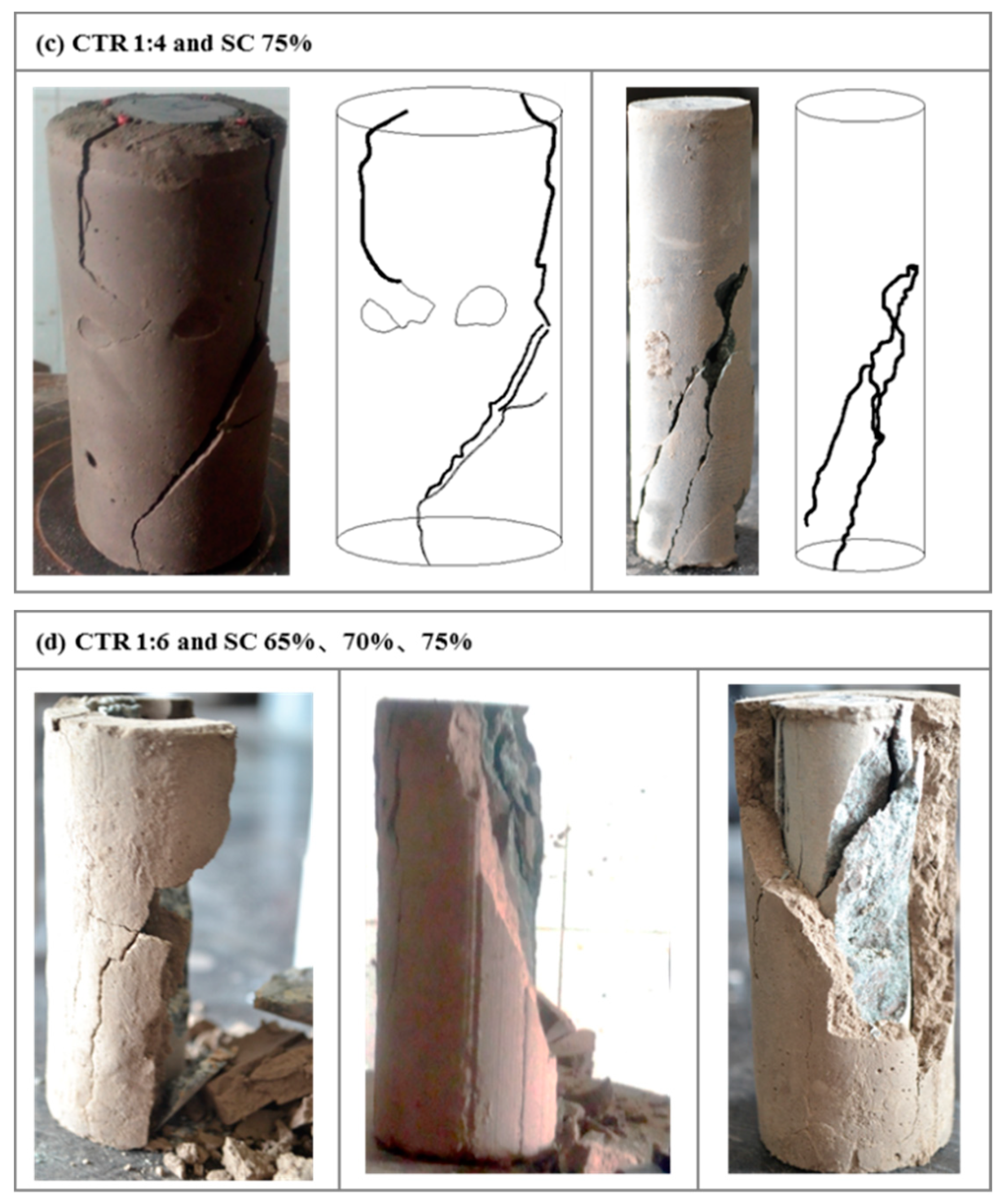




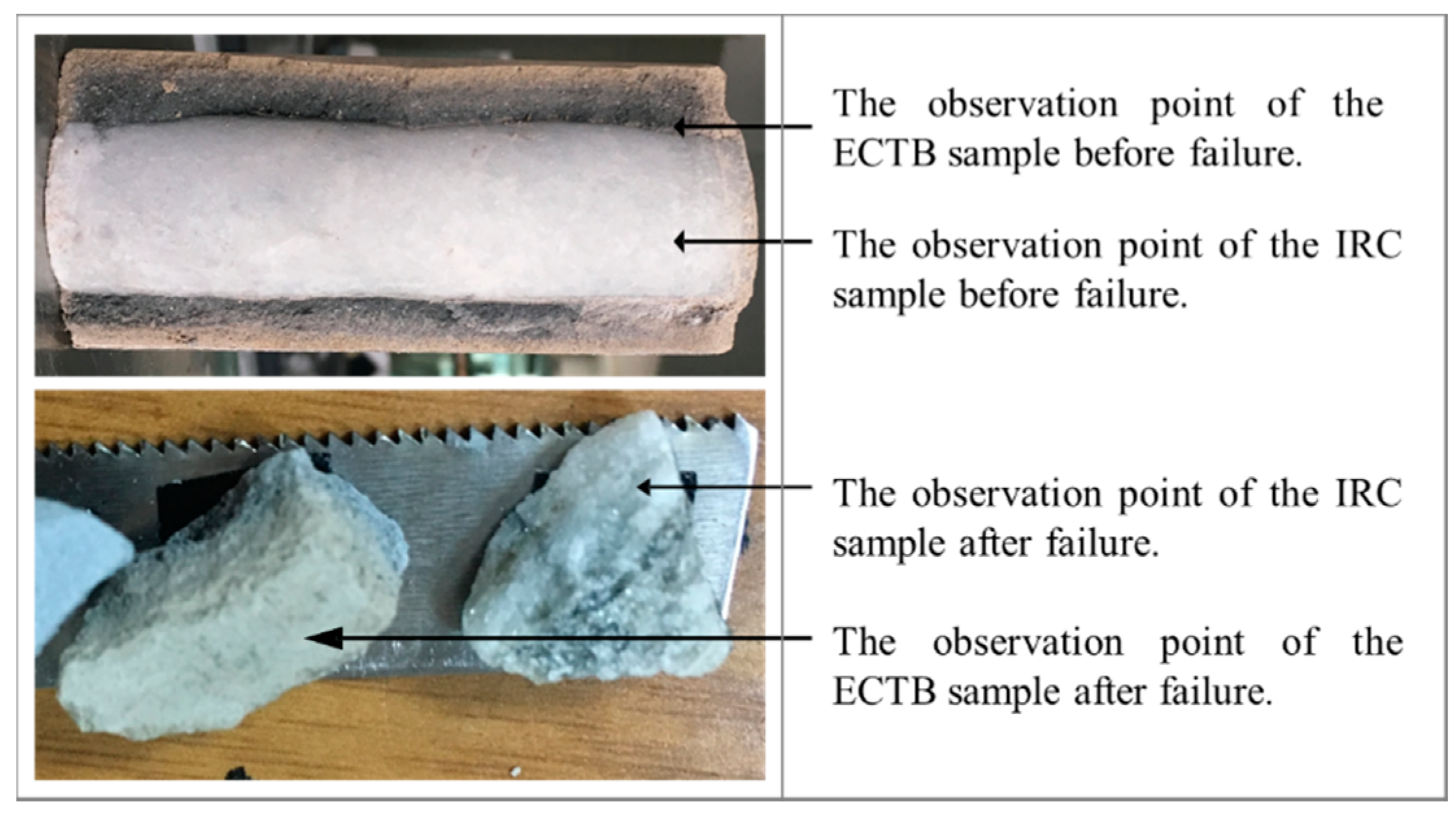

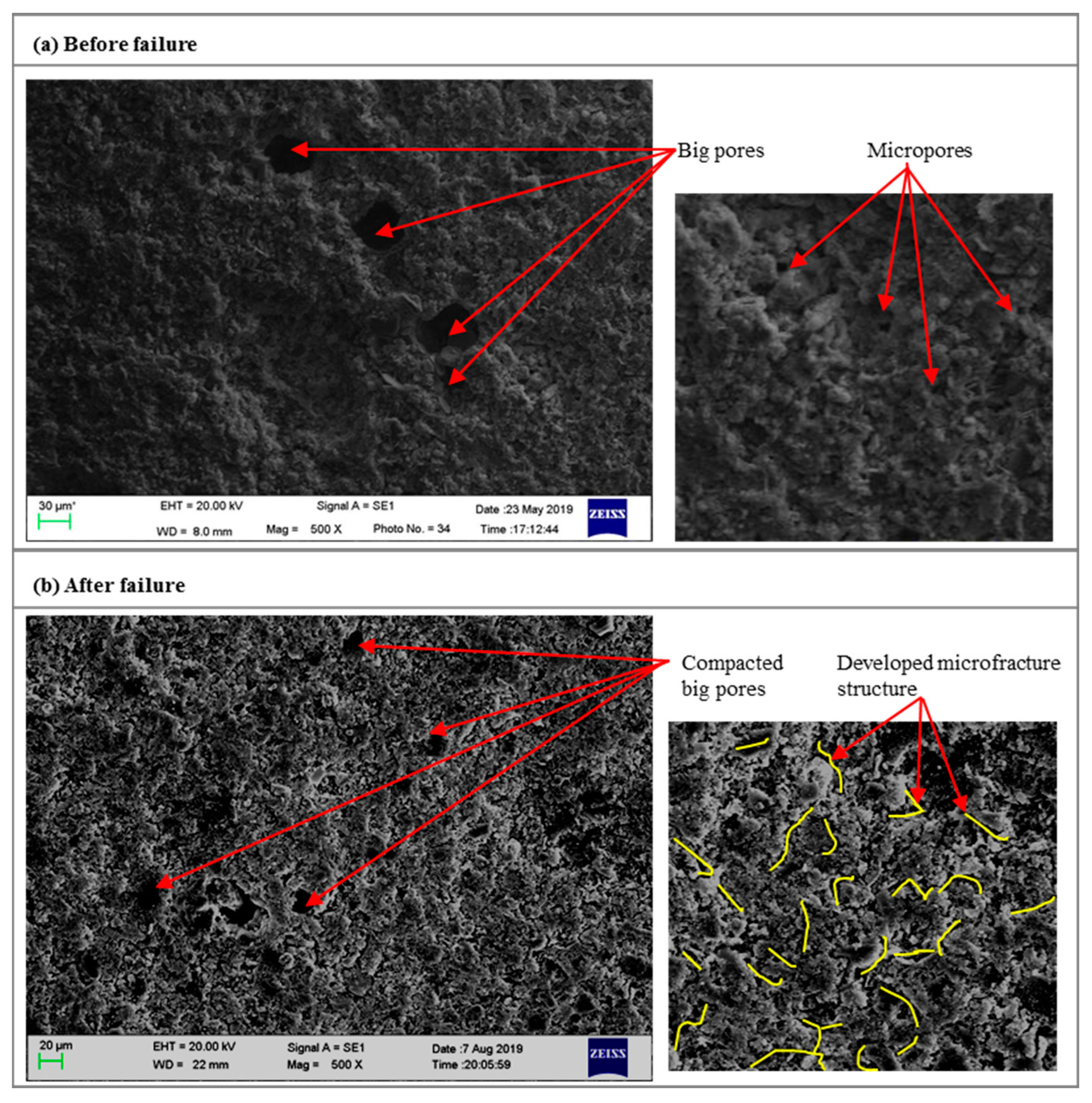
| SiO2 | K2O | Fe2O3 | Al2O3 | CaO | MgO | Na2O | CO2 |
| 62.9 | 5.86 | 1.16 | 15.2 | 2.31 | 0.90 | 3.10 | 7.20 |
| Cl | TiO2 | Cr2O3 | MnO | NiO | SrO | BaO | ZrO2 |
| 0.55 | 0.22 | 0.04 | 0.03 | 0.02 | 0.20 | 0.30 | 0.01 |
| CaO | Al2O3 | SiO2 | Fe2O3 | MgO | SiO3 | Na2O | K2O | TiO2 |
|---|---|---|---|---|---|---|---|---|
| 62.19 | 4.67 | 21.56 | 3.69 | 2.87 | 1.91 | 0.21 | 0.68 | 0.16 |
| NO. | Smectite | Illite | Kaolinite | Chlorite | Quartz | Potash Feldspar | Plagioclase | Calcite |
|---|---|---|---|---|---|---|---|---|
| 1 | - | 13 | 34 | 14 | 2 | 13 | 21 | - |
| 2 | - | 4 | 41 | 12 | 6 | 17 | 13 | 5 |
| 3 | 31 | 13 | 8 | 3 | 10 | - | - | 44 |
| 4 | 29 | 33 | 2 | 2 | 2 | 16 | 2 | 8 |
| 5 | - | 12 | 19 | 15 | 6 | - | 48 | - |
| Number of CTB-RC Specimens | CTR1:4 | CTR1:6 | CTR1:8 |
|---|---|---|---|
| SC 65% | 1 | 1 | 1 |
| SC 70% | 1 | 1 | 1 |
| SC 75% | 4 | 1 | 1 |
| Specimens | Size | SC | UCS Values/MPa | |||
|---|---|---|---|---|---|---|
| Diameter/mm | Hight/mm | CTR1:4 | CTR1:6 | CTR1:8 | ||
| CTB-RC specimens | 50 | 100 | 65% | 23.87 | 23.10 | 21.52 |
| 70% | 25.99 | 25.31 | 24.25 | |||
| 75% | 27.66 | 26.71 | 25.55 | |||
| CTB specimens | 50 | 100 | 65% | 1.72 | 1.34 | 1.05 |
| 70% | 1.95 | 2.13 | 1.78 | |||
| 75% | 3.38 | 2.96 | 2.07 | |||
| RC specimen A | 50 | 100 | - | 67.42 | ||
| RC specimen B | 25 | 100 | - | 18.74 | ||
© 2020 by the authors. Licensee MDPI, Basel, Switzerland. This article is an open access article distributed under the terms and conditions of the Creative Commons Attribution (CC BY) license (http://creativecommons.org/licenses/by/4.0/).
Share and Cite
Tan, Y.-y.; Zhang, K.; Yu, X.; Song, W.-d.; Wang, J.; Hai, C.-l. The Mechanical and Microstructural Properties of Composite Structures Made of a Cement-Tailing Backfill and Rock Core. Minerals 2020, 10, 159. https://doi.org/10.3390/min10020159
Tan Y-y, Zhang K, Yu X, Song W-d, Wang J, Hai C-l. The Mechanical and Microstructural Properties of Composite Structures Made of a Cement-Tailing Backfill and Rock Core. Minerals. 2020; 10(2):159. https://doi.org/10.3390/min10020159
Chicago/Turabian StyleTan, Yu-ye, Kai Zhang, Xin Yu, Wei-dong Song, Jie Wang, and Cheng-long Hai. 2020. "The Mechanical and Microstructural Properties of Composite Structures Made of a Cement-Tailing Backfill and Rock Core" Minerals 10, no. 2: 159. https://doi.org/10.3390/min10020159




